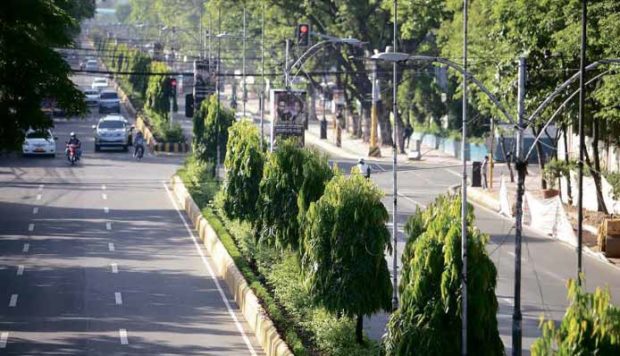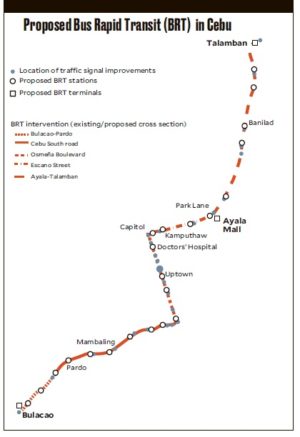2,000 trees to give way to P10.6-B BRT project

DOOMED Trees along Escario Street, one of Cebu City’s main thoroughfares,may have to go as part of preparations for the P10.6-billion Bus Rapid Transit project to ease traffic in the metropolis. —TONEE DESPOJO/CEBU DAILYNEWS

Ruiz now fears the trees would disappear as the city government starts work on the P10.6-billion Bus Rapid Transit (BRT) project designed to ease traffic on the city’s major roads.
“I can’t imagine what will happen once the trees are removed,” she said. “It will become very hot. It may not be bearable anymore.”
Ruiz’s house is along Escario Street, where trees were removed for a road-widening project in the 1990s.
The remaining trees still standing after that project, among more than 2,000 trees around the city, would now have to give way to the BRT, which spans 21.5 kilometers from the village of Bulacao in the south to Talamban in the north.
Residents and environmentalists have raised concern.
Nida Cabrera, a former city councilor and now environmental consultant to Mayor Tomas Osmeña, said 1,985 trees would be earth-balled and the rest, or 197, would be cut down.
P15M for earth-balling
At least P15 million had been allotted for the earth-balling of trees, an amount to be taken from a P35-million “green” component of the project that would be financed by the Department of Transportation and Communications and enforced by the Cebu City Environment and Natural Resources Office.
The money would also fund the planting of 350,000 seedlings and saplings to replace the trees that would be cut.
At least 665 of the trees are narra, 471 fire trees and 203 mahogany.
Many of the others are fruit-bearing trees.
The trees, which are either on sidewalks or traffic medians, have trunk diameters of 10 to 80 centimeters.
The BRT would pass through 21 villages, including Bulacao, Pardo, Mambaling, Sambag 1, Sambag 2, Capitol Site, Kamputhaw, Barrio Luz, Apas, Banilad and Talamban.
Most of the trees are in the southern district, where roads would be widened to accommodate buses that would replace jeepneys, according to Rafael Yap, head of the BRT implementation unit.
While it is not be the first time that the city will transfer or cut trees for make way for projects, this is the first time that the number of trees to be removed is this big.
Trees earth-balled in the past have remained healthy, according to the Cebu City Parks and Playgrounds Commission (CCPPC).
There are many areas in the city that could accommodate the nearly 2,000 trees that would be earth-balled, said Librado Macaraya, CCPPC executive director.
Century-old acacias
Proof of the success of earth-balling efforts may be seen in Plaza Independencia, a park in the city where at least two 100-year-old acacia trees have survived transfer, according to Joselito Baclayon, a former city agriculturist.
The acacia trees were transferred when a tunnel for South Road Properties project was built, Baclayon said.
The city has also transferred several trees from the SRP site, Cebu South Coastal Road and a road near the University of Cebu.
According to Baclayon, proper handling is key to the survival of trees that are being transferred. Cuts, or wounds on trunks, could aggravate the stress that trees suffer during transfer, he said.
Narra, mahogany and fire trees are known to be more adaptable to being earth-balled and will most likely survive the process.
Dr. Armando Palijon, a professor in silviculture, arboriculture and urban forestry at the Institute of Renewable Natural Resources of the University of the Philippines Los Baños, said earth-balling had become expensive because of the need to use heavy equipment like a crane or backhoe and hire skilled workers.
Experts should also oversee the earth-balling process, Palijon said.